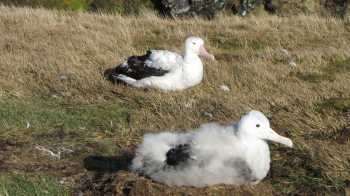Gilles Gauthier of the Département de Biologie, Université Laval, Quebec, Canada and colleagues in Canada and France, publishing last year in the Journal of Ornithology, have used a modelling approach to study dispersal, recruitment and survival in the biennially-breeding Wandering Albatross Diomedea exulans from the Crozet Islands.
The paper's abstract follows:
"The study of dispersal or recruitment in long-lived birds using capture-recapture methods is challenging because temporary emigration is often a source of heterogeneity in detection probabilities. To deal with this problem, we introduced unobservable states in the multistate, spatial recruitment model of Lebreton et al. (Oikos 101:253-264, 2003) to study dispersal, recruitment and survival in the Wandering Albatross (Diomedea exulans), a species with a biennial reproduction (individuals skip breeding following a successful reproduction). We highlight some of the limitations and challenges encountered in using this approach. Our dataset came from a 36-year capture-recapture study conducted at three colonies of the Crozet archipelago. The model had five reproductive stages: pre-breeders, successful breeders, failed breeders, and birds in the year after a successful or a failed breeding attempt, which are unobservable. In adults, movements between colonies (i.e. breeding dispersal) were nested within reproductive stages. Several models with different constraints on survival equally fitted the data but had some rank deficiencies (i.e. non-identifiable parameters). Survival estimates were most biologically realistic (from 0.91 to 0.95) when survival was set equal between observable/ unobservable states but free to vary between successful/ failed breeders and among colonies. Age-specific recruitment probabilities peaked at 9-10 years and appeared well estimated despite limitations in setting the age of constant recruitment probability. Modelling natal dispersal and recruitment required a simplification of the structure of the model due to computer limitations. When applying the complete and reduced versions of the model to the same dataset, we found that survival was well estimated in both cases. Some transition probability estimates were also similar, but transitions from unobservable to observable states were poorly estimated in the simplified version. We conclude that the simplified version of the model should be limited to the estimation of natal dispersal and that the model with a full structure should be used to estimate breeding dispersal."

Click here for details of a related paper by the same authors.
Reference:
Gauthier, G., Milot, E. & Weimerskirch, H. 2010. Estimating dispersal, recruitment and survival in a biennially breeding species, the Wandering Albatross. Journal of Ornithology DOI 10.1007/s10336-010-0541-9.
John Cooper, ACAP Information Officer, 10 January 2010

 English
English  Français
Français  Español
Español